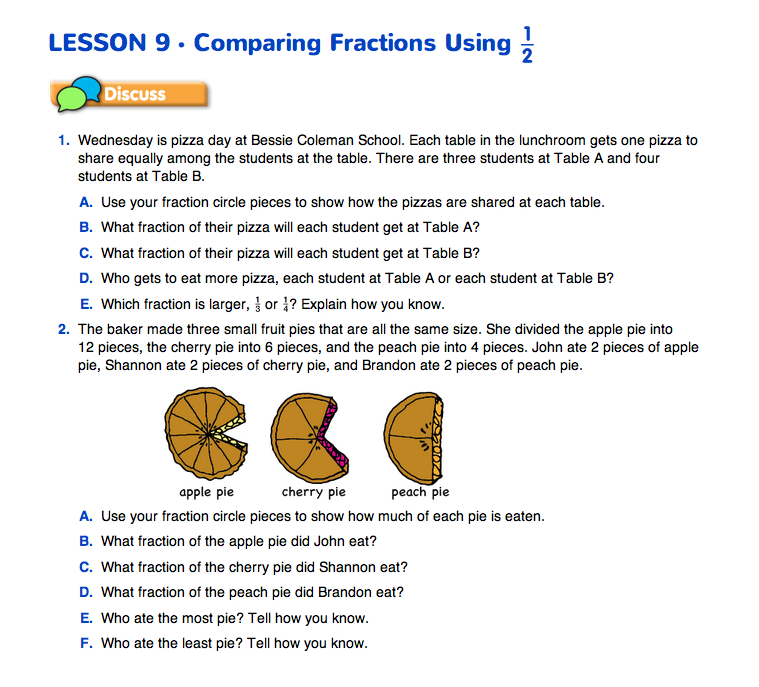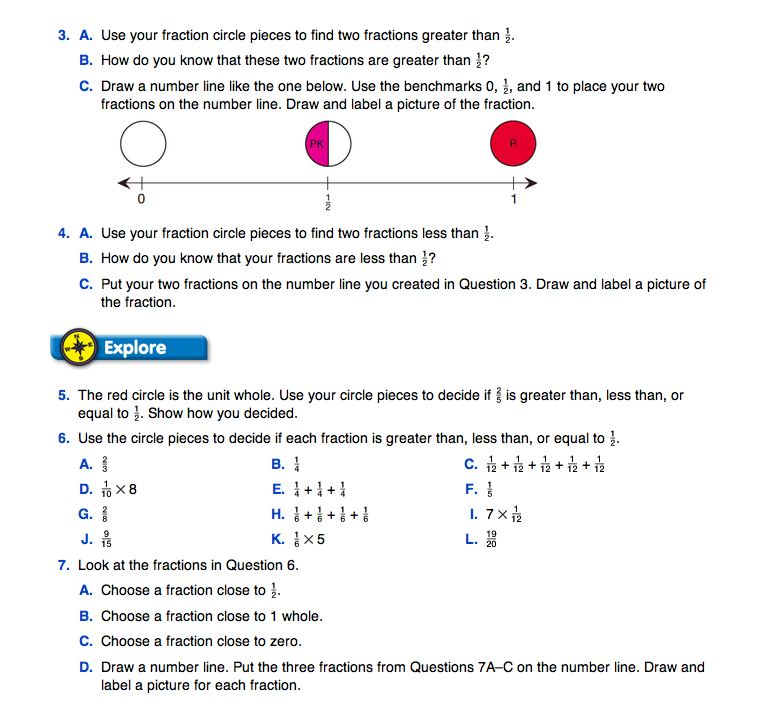Use Denominators to Order Fractions. Launch this lesson by introducing the pizza problem in Question 1 of the Comparing Fractions Using 1/2 pages in the Student Guide. Student pairs use their fraction circle pieces to answer and discuss Questions 1B–E. Ask a few students to share their strategies for Question 1D.
- What is the unit whole in the problem? (a whole pizza)
- Who ate more pizza, each student at Table A or Table B? (Each student at Table A. Possible explanations: The orange pieces are larger than the yellow. Students at Table A have to share with fewer people than Table B.)
- What do you notice about the numerators in this problem? (They are both 1.)
- What do you notice about the denominators in this problem? (They are different.)
- What do the denominators tell about which fraction is larger? (The larger the denominator, the smaller the piece of pizza, because the whole is shared with more people.)
- Name a fraction smaller than 1/4.
(Possible responses: 1/8 or 1/12)
Continue this discussion with Question 2. Like the pizza problem, students are comparing the eaten portion of each pie. Give student pairs a few minutes to answer Questions 2A–F. While they are working, choose a few students to create a fraction card on an index card for each of the fractions (2/12, 2/6, and 2/4) in this problem. See Figure 2 for an example. After pairs have had a chance to solve the problems, ask a few students to share their strategies for Questions 2E and 2F.
- What is the unit whole in this problem? (A whole pie)
- Who ate more pie? (Brandon ate the most. Possible explanation: Two yellow pieces are larger than two black pieces. His pie was divided into fewer pieces, so each is larger.)
- What do you notice about the numerators in this problem? (They are all 2.)
- What do you notice about the denominators in this problem? (They are different.)
- What do the denominators tell about which fraction is larger? (The larger the denominator, the smaller each piece of pie.)
- Explain why that is true. (The denominator tells how many equal pieces are in the pie. A larger denominator means the pie will be divided into more pieces. More pieces means smaller pieces.)
- Put the fractions 2/6, 2/4, and 2/12 in order from smallest to largest. (2/12, 2/6, 2/4)
- How did you decide the order for these fractions? (Possible response: I looked at the numerators and they were all the same, so I knew I could use the denominators to put them in order. I know that the bigger the denominator the smaller the fraction because it means that the whole is divided into more pieces, so each piece would be smaller. I knew 2/12 was the smallest, 2/6 was next, and 2/4 was the largest.)

Students need many experiences with concrete materials such as circle pieces and fraction strips to develop mental images of fractions, so they can develop number sense for fractions. Visually comparing to benchmarks like 1/2 is a powerful strategy for determining relative sizes of fractions.
Use a Benchmark Number Line. Show students the number line you created (Figure 1 or 3) and point out how the fraction circle pieces relate to the pictures above the number line.
Help students make the connection between the area model of a fraction and the number line representation.
- What fraction circle piece is the unit whole on this number line? (the red circle)
- Where is the red circle placed? (above number 1)
- Why is the red circle placed at “1”? (Because 1 is the whole distance we are looking at.)
- What is the unit whole on this number line? (The entire distance between 0 and 1.)
Using the fraction cards the students created for Question 2, discuss where these fractions are on the number line.
- 2/4 of the peach pie is eaten. Where does this fraction go on the number line? How do you know? (At the 1/2 benchmark. Possible explanation: 2/4 is equal to 1/2 because I can cover the 2 yellow pieces with 1 pink piece; 2 is half of 4, so I know that 2/4 is equal to 1/2.
- Which fraction is larger, 2/12 or 2/6? How do you know? (2/6 is larger because both numerators are 2, and sixths are larger than twelfths.)
- Is 2/6 larger or smaller than 1/2? How do you know? (2/6 is smaller than 1/2. Possible explanation: because I cannot cover a pink piece with 2/6.)
- Is2/6 closer to 1/2 or to zero? How do you know? (Closer to 1/2 , because most of the pink piece is covered.)
- Where does 2/6 go on the Benchmark Number Line? [Place the appropriate fraction card between zero and 1/2 but closer to 1/2.]
- [Refer to the 2/12 fraction card.] Is 2/12 larger or smaller than 1/2? How do you know? (2/12 is smaller than 1/2. Possible explanation: 6/12 would be equal to a half because 6 is half of 12 and 2/12 is less than 6/12.)
- Is 2/12 closer to 1/2 or to zero? How do you know? (Closer to zero, because I know 6/12 equal 1/2 and the numerator 2 is closer to zero than to 6.)
- Where does 2/12 go on the Benchmark Number Line? [Place the appropriate fraction card between 0 and 1/2 but closer to zero.]
Fractions Between 1/2 and 1. Question 3 asks students to find two fractions greater than 1/2 using fraction circle pieces. Ask students to work on this problem in small groups. Students tell the members of their group how they know their fractions are larger than 1/2 . While students are working, choose a few students and give them an index card to create more fraction cards to place on the class number line. After groups have discussed Question 3, collect some sample responses from the class. Have the students model and record their responses and place fraction cards in the appropriate places on the Benchmark Number Line.
- How do you know this fraction is larger than 1/2? (Possible response: I can see that one pink (1/2) covers some of the fraction, but there is some not covered.)
- How do you know if this fraction is closer to 1/2 or closer to 1 whole? (Possible response: I look at the size of the piece not covered by 1/2 . If the leftover part is close to the size of the pink piece, then the fraction is close to 1 whole.)
- Where should this fraction go on the Benchmark Number Line?
Place the student-created fraction cards on the display of the Benchmark Number Line between 1/2 and one. Some will be placed closer to a whole and others closer to 1/2. Stack fraction cards with equivalent fractions. Some fractions may be too close to each other for students to determine the exact order.
Fractions between 0 and 1/2. Question 4 asks students to find two fractions smaller than 1/2 using fraction circle pieces. Students should explore this question in small groups as they did for Question 3. While students are working, choose a few students and give them an index card to create a fraction card to place on the display of the Benchmark Number Line.
- How do you know this fraction is smaller than 1/2? (Possible response: The fraction covers part of a pink piece, but not all.)
- How do you know if this fraction is closer to 1/2 or closer to 0? (Possible response: If the fraction covers most of the pink piece, then the fraction is closer to 1/2. If it covers very little of the pink piece, then the fraction is closer to zero.)
- Where should this fraction go on the Benchmark Number Line?
Place the student-created fraction cards on the Benchmark Number Line between zero and 1/2. Place some closer to zero and others closer to 1/2 . Stack fraction cards with equivalent fractions. Some fractions may be too close to each other for students to determine the exact order.
Assign Questions 5–7 on the Comparing Fractions Using 1/2 pages in the Student Guide. The Sample Dialog Box 1 has three examples of possible strategies for Question 5.

Below are student responses to Question 5: Is 2/5 greater than, less than, or equal to 1/2? Use these as models to better understand what your students are thinking.
Alex
Alex: I think 2/5 is less than 1/2 because I looked for 1/2 (pink piece) and the fraction is smaller than 1/2.
Teacher: Is 2/5 closer to 1/2 or closer to zero?
Alex: 2/5 is closer to 1/2 because the fraction covers most of the 1/2 (pink) piece. [Alex drew the picture below.]

Lily
Lily: I think 2/5 is greater than 1/2 because 1/2 is a larger fraction than 1/5.
Teacher: Does the problem ask you to compare 1/5 or 2/5?
Lily: 2/5.
Teacher: Is 1/5 equal to 2/5?
Lily: No, this is 2/5. [She uses the green circle pieces.]
Teacher: Is 2/5 greater than or less than 1/2?
Lily: [Pause] I looked at the bottom number [denominator] and forgot that I have to look at the top number, too. When I look at the fraction pieces I can see that 2/5 is a little less than 1/2.
Teacher: Is 2/5 closer to 1/2 or zero?
Lily: 1/2 because 2/5 is only a little bit less than 1/2.
Julie
Julie: I think 2/5 is less than 1/2 but I did not use the circle pieces.
Teacher: What did you do?
Julie: I know that 2 1/2 is half of 5. So 2 is less than half of 5 and 3 is more than half of 5. So 2/5 is less than 1/2 and 3/5 is bigger than 1/2.
Teacher: That is an interesting strategy. Do you think that would work all the time? Try a different problem.
Julie: Okay, 5/12 is less than 1/2 because 6/12 is equal to 1/2 and 5/12 is less than 6/12.
In Question 6, students will use the fraction circle pieces to solve some repeated addition and multiplication number sentences before determining if the fractions represented are greater than, less than, or equal to 1/2.
As students are solving Question 7, choose a few students to create a fraction card to place on the Benchmark Number Line. Review Questions 7A–C with the class using the student-created fraction cards and the Benchmark Number Line.
Assign Questions 8 and 9. Remind students of how to use the symbols <, >, and =. Question 9 presents a common misconception a student might have when comparing fractions. Ask students to discuss what they would tell Frank about his comparison.
Students are not expected to master comparing fractions using numerical relationships in symbols in fourth grade. Students need experiences with concrete models to develop a quantitative notion of fractions. Students should be allowed and encouraged to use models at this level.
Questions 1–3 of the Homework Section in the Student Guide can be assigned after Part 1.



















